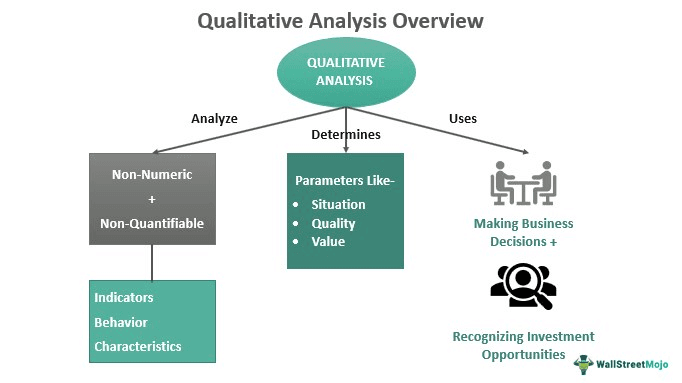Table Of Contents
Qualitative Analysis Definition
Qualitative analysis is a method to analyze a certain subject using non-numeric plus non-quantifiable indicators, behavior, and characteristics to determine its overall situation, quality, value, or any other parameter. It lies at the core of making business decisions and recognizing investment opportunities by investors and companies.

The qualitative analysis deals with non-numeric data like human behavior in business. The qualitative analysis depends on abstract concepts like brand reputation and includes the reason and explanation of human behavior. It mostly deals with the meanings of attributes and characteristics of an item, business, or subject.
Key Takeaways
- Qualitative analysis uses non-numeric aspects of a subject to ascertain and assess its value, quality, or performance without any quantified data like leadership style.
- It is helpful for investors and companies in making appropriate investment decisions.
- It mostly focuses on a business parameter's nontangible, human aspect without considering any numeric financial data.
- The five main methods to conduct qualitative analysis includes content analysis, narrative analysis, grounded analysis, framework analysis, and discourse analysis.
Qualitative Analysis Explained
Qualitative analysis in research is a method to analyze nontangible aspects of a subject to evaluate its characteristics, reputation, and performance. Subjective assessments are the key to evaluating non-numeric attributes like human resources, leadership quality of management, company morale, and the company's brand image. It is a non-scientific approach to seeing things that are difficult to express in numbers.
It takes the form of the art of assessing trends and business traits instead of a scientific approach. The tendency to analyze anything qualitatively comes from experience, understanding, and intuition over years of rigorous practice. Using quantitative and qualitative analysis to make the right investment decisions in securities is better.
Economists and analysts initially developed qualitative analysis data to measure the risk. Analysts used it while applying the qualitative research hypothesis. However, it evolved into a full-fledged business and securities performance analysis method. Analysts apply the method to understand the company's culture and the people working there. In addition, it enables the company to look at every promotion & marketing of the product through the eyes of customers.
Methods
Analysts cannot conduct the qualitative analysis methods using statistical and mathematical models as it does not concern any numeric aspect of data. Hence, there are five major methods of performing qualitative analysis, namely:
1. Content Analysis
It includes researching and collecting data through surveys, emails, chats, and social media. Then the data is effectively presented, accompanied by approaches like a directive, conventional and summative.
2. Narrative Analysis
It collects and utilizes data related to personal accounts, letter writing, and journals to interpret the meanings of their daily lives, work, and world.
3. Grounded Analysis
It augurs theory formation by utilizing – text interpretation, core groups, open-ended question answers, and observations of participants.
4. Framework Analysis
Researchers deploy summarization to handle and arrange data through – similarity identification and qualitative data differences. The method is useful in generating conclusions that are descriptive as well as explanatory.
5. Discourse Analysis
As the name indicates, the linguistic aspect of community building is its focus. As a result, it primarily deals with interpreting communication language and various texts.
Examples
Let us look at some qualitative analysis examples to get a good grasp of the topic.
Example #1
Let's consider an aerospace company Airzoop. It's related to human travel and the launch of satellites into space. It hires a new managing director (MD) to lead its rapidly expanding business for better operational excellence. As soon as the news spreads in the market, the shares/securities of Airzoop jumped by 10% on the day of the management takeover.
Moreover, the next day, the securities and shares kept climbing to new records for Airzoop. However, the rise is not logical according to quantitative analysis. The price of securities rose without any data to back them up. In a way, no quantitative data could explain the phenomenal rise in securities prices. Only one factor could be responsible for the price rise, which is the excessive buying of Airzoop shares by the securities traders in anticipation of qualitative reasons like the excellent track record of the new MD and his leadership style.
Example #2
Suppose a restaurant called Dinefine offers Sushi to its local customers in Japan. Later, the restaurant owner migrated to the United States for better business avenues. Incidentally, a news report comes across the restaurant owners that reports on the American food taste. The report says that most Americans are willing and open to trying South Asian cuisines, and most customers like a gourmet-level dish instead of fast food.
Therefore, this piece of qualitative information indicates that a special niche in the restaurant sector existed in America, which could use to begin and establish gourmet-level restaurants based on foreign dishes. Hence, the Dinefine restaurant owner opened a Japanese gourmet-level Sushi restaurant which became an instant hit. Further, 50 new branches of the same restaurant opened in the country, with new outlets added every year in each state.
All this happened due to qualitative analysis by the restaurant owner, who felt that the non-quantifiable niche of gourmet-level Sushi had a good chance to be a hit with food lovers of America.
Example #3
A qualitative analysis example includes a report on the COVID-19 outbreak in the dating app industry.
The global dating apps market research report gives an insightful overview of the pre and post-COVID-19 situation, current market trends, and forecasts for the market situation toll 2027. The report conducted a qualitative and qualitative analysis and highlighted key market components. Furthermore, it studied the industry and provided information about the strengths, weaknesses, opportunities, and threats in the dating apps market industry. It also highlights growth protection by researching dynamic information in the global markets.

